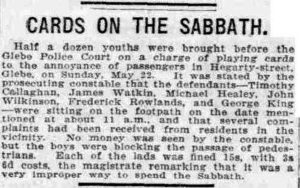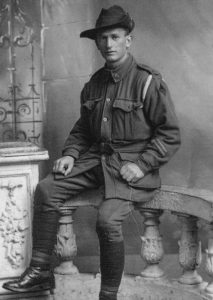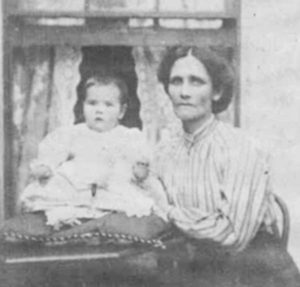By Rodney Hammett, Bulletin 10/2022, December
A recent enquiry to heritage@glebesociety.org.au asked about the whereabouts of Cooper’s Building on Parramatta St. A relative had been recorded as living there when they had been baptised at St Lawrence Church in George St on 23 March 1856.
Lyn Collingwood and I were able to advise them that this building of 12 shop-houses had been constructed for Robert Cooper in the early 1840s and had been located on the southern side of current Broadway, approximately where the existing Telstra Exchange is located, near City Rd. In the course of email exchanges I also found that others in the same family lived in Hegarty St, Glebe from 1909 to 1916.
Investigations of the 22 families who were living in Hegarty St at this time revealed numerous fascinating stories and I contemplated writing about them all as a ‘Snapshot in Time’ however that would have taken up too much space in the current Bulletin. It was then that a newspaper article from Evening News of Wednesday 1 June 1910 caught my eye.

The six youths brought before the Glebe Police Court in May that year for playing cards on Sunday 22 March, were Timothy Callaghan, James Watkin, Michael Healey, John Wilkinson, Frederick Rowlands and George King.
Of these six, three lived in Hegarty St – James Watkin (17), Frederick Rowland (18) and George King (16).
James Watkin lived in No 2 with his mother Mary and three siblings. Born in Glebe in 1893, James was the second child, with an older brother, a younger sister and a younger brother. A further brother and sister had died as infants.
Charles Watkin with wife Mary and family had arrived in Hegarty St in 1899. Charles was from Derbyshire, England, a machinery expert working for the Federal Sheep Shearing Company. She was from Grenfell, NSW and they had married in Sydney in 1890. In October 1906 Charles was found dead while doing maintenance work for the shearing machines at Canoon Station in the Riverina area of NSW. He was 51, The coroner’s report suggested he died of heart and lung problems, which had been accelerated by his drinking habits.1 Mary then took on the task of bringing up her children, which expanded to include four nephews and nieces from her sister’s family when their parents died between 1901 and 1915.
The family moved to live at 135 Wigram Rd, Forest Lodge in 1918. Following Mary’s death in 1930 James and his sister Ann Veronica (1894-1958) moved to Catherine St, Leichhardt. James had become a tailor by 1930 and in the late 1940s was a dry cleaner. He never married and died in 1950 aged 57.
Frederick Rowland lived at No 25. The Rowland family had moved here in 1907 and remained for 21 years. John Rowland, born in 1868 and one of 14 siblings, was the head of the household and had grown up in the Paddington area of Sydney. He and Edith Fanny Hill married in April 1891 and by 1907 already had nine children. Their last, Arthur, was born in 1910. John was a carrier.
Their eldest, Frederick John (b. 1892) was an iron worker when he enlisted for World War I in October 1916, then in October 1917 he was sent to the front in France, as part of a machine gun company. Here in late 1917, he caught a severe bout of lobar pneumonia from which he never recovered. Frederick was repatriated to Australia in May 1918 and finally discharged in Sydney in November that year. The world had to wait another 22 years, until 1940, before antibiotics became available for this and similar ailments.
Frederick was unable to return to his previous employment and it would have been difficult returning to a normal life. To some of his friends it might not have been a shock to read on 26 July 1926 that he had died suddenly up on the Hawkesbury River. This set in motion a series of events that affected the whole family. First Fanny, the matriarch, died on 1 August 1926 followed three months later by John who gassed himself at home on 1 November. The Evening News of 8 November covered details of the coroner’s report, which included details of John’s body being found at No 25 when his 20-year-old son returned home from work.
George King lived at No 23. The King family lived here from 1908 to 1911. Scottish born James McCartney King had married Irish born 23-year-old widow Sarah Tucker (neé McGee) in 1880 at St Paul’s Church, Redfern. They had seven children but likely it was only the youngest four who lived in Hegarty St, one of whom was George.

George Joseph King, b 1894, a labourer, enlisted for Word War I on 19 July 1915, nominating his mother living at 60 Francis St, Glebe as his next of kin. In 1912 the family had moved to 9 St John’s Rd and tragically in the same year his brother Stephen (aged 23) died in March and then his father James (aged 60) died in April.
George was not tall (only 5ft 2½ ins), had a ruddy complexion with grey eyes and auburn hair.2 Before he left for the War George married 17-year-old Elsie May Rigby in Glebe on 24 August 1915. On arrival in Europe in December 1916 his regiment was sent to France where he suffered from trench foot. He nevertheless remained in France to fight for most of 1917, only being send to a hospital in England in November. He was returned to France in late December then from January 1918 he fought in Belgium, in June was promoted to Lance Corporal and in November at the cessation of fighting, he returned to England. In March 1919 Lance Corporal George Joseph King was awarded the Military Medal for bravery.
It took until July 1919 before he was discharged in Sydney. Meeting George on his return was a very proud Elsie and their three-year-old son George, who had been born in 1916. Another son, Cecil, was born in 1921.
The family lived in Glebe, George returning to a labourer’s job. They lived in Darling St and Bellevue St before settling at 89 Mitchell St. Elsie died in 1969 and George in 1970, both being buried at Rookwood Cemetery.

And what of the family that got me started on this journey? They were the Slater family who lived at No 12 Hegarty St from 1909 to 1916. William Robert Slater (1871-1952) was born in Goulburn and married Frances Elizabeth Stevens at St Paul’s Church, Redfern on 20 November 1894. Frances was a Sydney girl, born in June 1876. They had a large family, even by the standards of that time, a total of 12 children and all lived to adulthood. By 1909 there were seven children. A further two were born at Hegarty St – Henry (1911-1985) and Ada (1913-2000) – and the last three were born at Punchbowl.
Suzanne Slater, a granddaughter of Frances remembers the family story of why they left Glebe. It was because of the war and to get away from Sydney Harbour in case an invasion came from there. William and Frances had in July 1914 secured a quarter acre block in a 66-acre subdivision at Scott St, Punchbowl which by 1916 had a house ready for the family. Another bock on Scott St was purchased by the family in 1921 on which three houses were built.
William was a carter in Glebe and also in Punchbowl.
Notes: 1. Trove: Riverine Grazier; Tue 9 October 1906, p. 2; 2. Service Records; WW1, SN 2406.









There are no comments yet. Please leave yours.